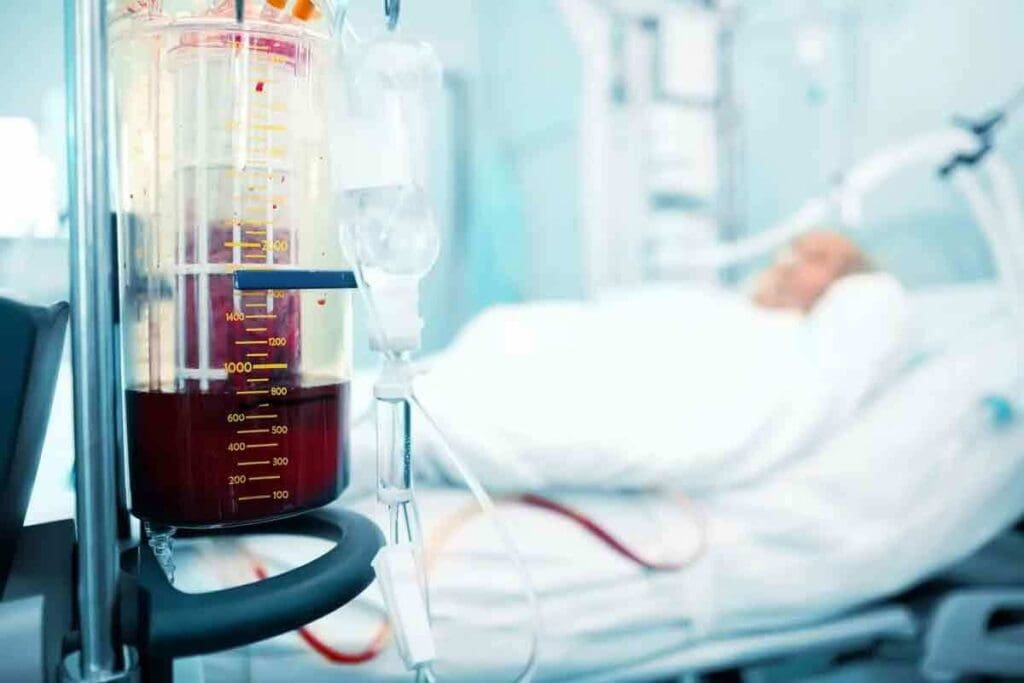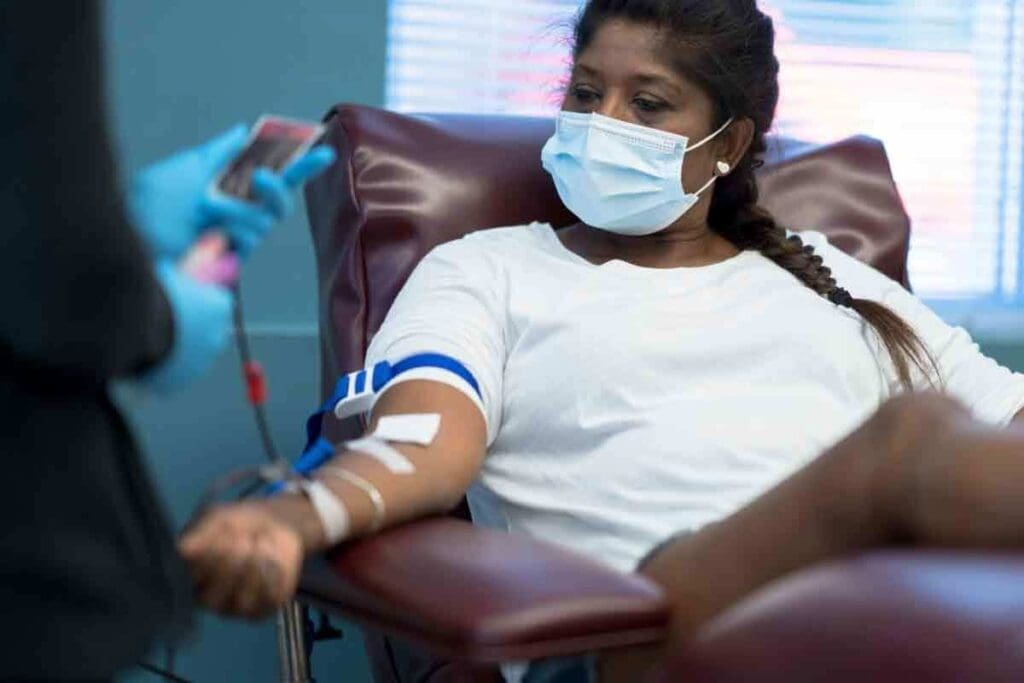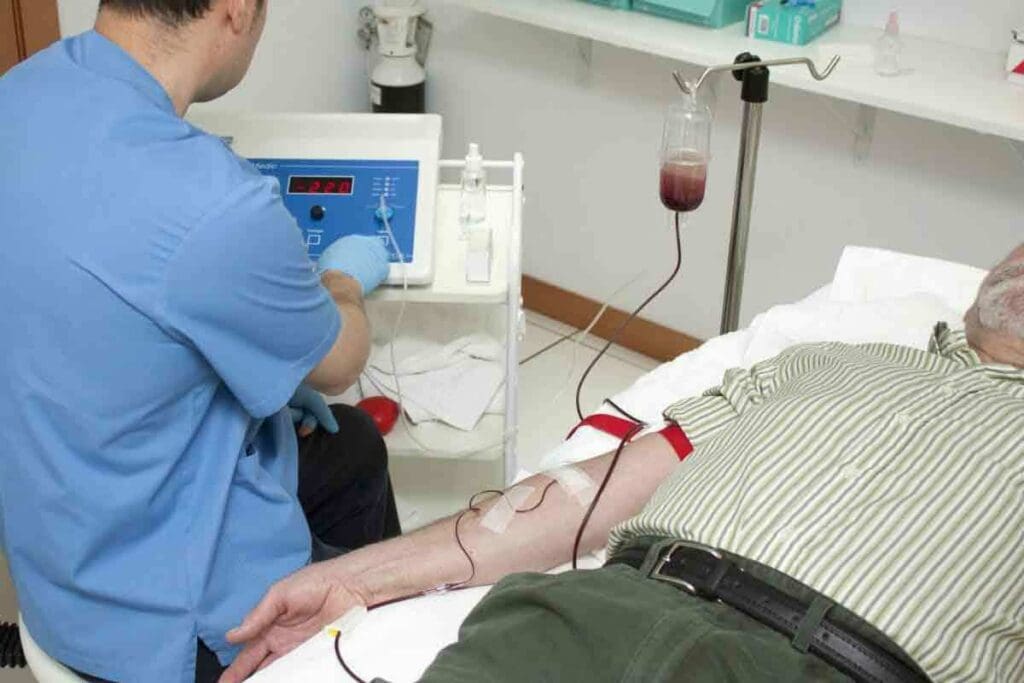Last Updated on November 14, 2025 by Ugurkan Demir

Knowing about O-positive blood compatibility is key in medical settings, like at LivHospital. Here, patient care is top priority. It’s vital to understand What Blood Type Can O Positive Receive to ensure safe and effective treatments.
O positive blood is very common and in high demand. It’s compatible with other Rh-positive blood types. People with O-positive blood can get blood from O-positive and O-negative donors. This makes having these blood types very important.
O-positive blood is great because it works well with other Rh-positive blood types. To make sure O-positive blood transfusions are safe, doctors need to know a lot about their compatibility. This shows how important it is to follow medical practices carefully.

The ABO blood group system is key to knowing about blood types. It sorts blood into four main groups: A, B, AB, and O. These groups are based on specific antigens on red blood cells.
The main blood groups are A, B, AB, and O. They are determined by the presence or lack of A and B antigens on red blood cells.
The Rh factor is a protein on red blood cells. If present, it makes a person Rh positive; if not, they are Rh negative. The Rh factor is important for blood transfusions because it affects compatibility.
Blood type comes from the genes of your parents. The ABO system and the Rh factor are the main factors in determining blood type.
| Blood Group | Antigens Present | Rh Factor |
| A | A | Positive/Negative |
| B | B | Positive/Negative |
| AB | A and B | Positive/Negative |
| O | None | Positive/Negative |
Knowing the ABO system and Rh factor is vital for safe blood transfusions. The table above shows the main blood groups and their features.

When it comes to blood transfusions, finding the right match is key. For O-positive individuals, this means getting blood from certain donor types. Knowing which blood types are compatible is vital for safe medical care.
O-positive individuals can safely get blood from two types: O-positive and O-negative. This is because O-type red blood cells don’t have A or B antigens. This makes them less likely to cause a bad reaction.
O positive blood is the best match for O positive recipients because it has the same Rh positive factor. O-negative blood is a universal donor type. It doesn’t have A or B antigens and is Rh negative. This makes it safe in emergencies when the recipient’s blood type isn’t known.
O-positive individuals can only get O-positive and O-negative blood because of their immune system. If they get blood with A or B antigens, their immune system might react. This could lead to a serious transfusion reaction.
O-negative blood is used in emergencies because it doesn’t have A or B antigens. This lowers the risk of a bad reaction. But, for regular transfusions, O-positive individuals usually get O-positive blood. This keeps their Rh-positive status compatible.
Here’s a chart to show who can give O-positive blood:
| Blood Type | Can Receive From | Can Donate To |
| O Positive | O Positive, O Negative | O Positive, A Positive, B Positive, AB Positive |
| O Negative | O Negative | O Positive, O Negative, A Negative, A Positive, B Negative, B Positive, AB Negative, AB Positive |
This chart shows that O-positive individuals can safely get blood from O-positive and O-negative donors. It shows how important these donor types are in transfusion medicine.
The science of blood type compatibility is complex. It involves antigens and antibodies. These are key to safe blood transfusions.
Antigens are on the surface of red blood cells. They can start an immune response. Blood types are based on certain antigens’ presence or absence. Antibodies are proteins that fight specific antigens, protecting us.
Transfusing incompatible blood can trigger an immune response. The body may make antibodies against the blood cells. This can destroy red blood cells, leading to serious issues like kidney failure or death.
Cross-matching is vital to avoid transfusion reactions. It checks if the donor’s blood is safe for the recipient. A mix of the recipient’s serum and the donor’s red blood cells is tested for any bad reactions.
| Blood Type | Can Receive | Can Donate To |
| O Positive | O Positive, O Negative | O Positive, A Positive, B Positive, AB Positive |
| O Negative | O Negative | All Rh-positive and Rh-negative types |
O positive blood is a key part of the world’s blood supply. It’s common and has traits that are important in hospitals.
O positive blood is found in many people around the world. About 37.4% of the global population has it. This makes it very important for blood banks.
The genes decide if someone has O-positive blood. It’s because of the lack of A and B antigens and the presence of RhD. Genetic inheritance patterns are key in determining blood type. O positive comes from a specific gene mix.
People with O-positive blood might have certain traits. But these are just general ideas, not proven facts. Traits like a strong immune system and lower heart disease risk are sometimes linked to it. More research is needed to understand these traits fully.
O-positive blood is very important for the world’s blood supply. Knowing about its traits helps doctors and patients. It shows how vital it is in healthcare.
O positive blood is very important in hospitals. It works well with many other blood types. This makes it very needed in medical places.
O positive blood is a universal donor for Rh-positive people. It can be given to patients with A+, B+, AB+, and O+ blood types. This is very helpful in emergencies when time is short.
O positive blood has a big problem. It can’t be given to people with Rh-negative blood. This is because Rh-negative people might make antibodies against the RhD antigen in O-positive blood. This could cause serious problems.
Hospitals always need O-positive blood. It’s very compatible, and emergencies happen often. The table below shows who can get O-positive blood and who can give it.
| Blood Type | Can Receive | Can Donate To |
| O+ | O+, O- | A+, B+, AB+, O+ |
| A+ | A+, A-, O+, O- | A+, AB+ |
| B+ | B+, B-, O+, O- | B+, AB+ |
| AB+ | All Rh+, All Rh- | AB+ |
The need for O-positive blood never stops. It’s key for medical treatments and surgeries. Hospitals must always have enough O-positive blood ready for patients.
O-negative blood is special because it can be given to anyone. This makes it very important in medical emergencies. It’s a key part of blood banks all over the world.
O-negative blood is rare because it doesn’t have A or B antigens and is Rh-negative. Only about 6-7% of people have this blood type. This makes it harder to find than other blood types.
In emergencies, O-negative blood is the first choice. It can be given to anyone, which is perfect for trauma patients, newborns, and those with unknown blood types.
It’s hard to keep enough O-negative blood because it’s rare and always in demand. Blood banks and hospitals work hard to collect and store it for emergencies.
| Blood Type | Population Percentage | Compatibility |
| O Negative | 6-7% | Universal Donor |
| O Positive | 35-40% | Compatible with O Positive and O Negative |
| A Negative | 2-3% | Compatible with A Negative and O Negative |
The table shows how rare O-negative blood is and how it can help everyone. This makes it very important in hospitals.
O-negative and O-positive blood differ mainly because of the RhD antigen. This antigen is key in blood transfusions, as it affects who can receive blood safely.
The RhD antigen is a protein on red blood cells of those with Rh-positive blood, like O positive. People with O-negative blood do not have this antigen. This decides if someone’s blood is Rh positive or Rh negative.
Key characteristics of the RhD antigen include:
The differences between O-negative and O-positive blood are important, mainly in transfusions and pregnancy. O-negative blood can be given to anyone in emergencies, as it matches both O-negative and O-positive types. But, O positive blood can only go to those who are Rh-positive.
Knowing someone’s Rh status is vital for safe blood transfusions. Blood typing tests are used to find this out. These tests include:
These tests are key to figuring out someone’s Rh status and making sure blood transfusions are safe.
O positive and O negative blood types are key in saving lives. They can be given to patients with different blood types. This makes them universal donors.
O positive donors are in high demand. They can donate to anyone with A or B positive blood types. O-negative donors are also vital. Their blood can be given to anyone in need, no matter their blood type.
Hospitals and medical facilities always need blood. They rely on O-positive and O-negative donors. These donations are essential for surgeries, emergency treatments, and managing chronic conditions.
The blood donation process is simple and safe. First, donors are checked for eligibility based on their health and other factors. The whole process takes about an hour, including registration and the donation itself.
To donate blood, you must be healthy and between 17 and 65 years old. You also need to meet certain weight and hemoglobin requirements. O-positive and O-negative donors are encouraged to donate often. Their blood types are always in demand.
Blood donations from O-positive and O-negative donors help in many medical situations. They are used in emergency surgeries and for patients with blood disorders. Every donation can save up to three lives.
Donating blood makes a big difference in your community. Regular donations help hospitals have enough blood for transfusions. This supports medical care and saves lives.
For O-positive individuals, knowing their blood type is key to safe medical care. Being aware of their blood type greatly affects their health during medical procedures.
O positive individuals should tell their healthcare providers about their blood type before surgery. This is important because they can get blood from O-positive or O-negative donors. Making sure the blood is compatible is vital to avoid transfusion reactions.
Blood Type Compatibility Chart
| Blood Type | Can Receive From | Can Donate To |
| O Positive | O Positive, O Negative | O Positive, A Positive, B Positive, AB Positive |
| O Negative | O Negative | O Positive, O Negative, A Negative, A Positive, B Negative, B Positive, AB Negative, AB Positive |
During pregnancy, O-positive women need to watch out for Rh incompatibility if their baby is Rh-negative. Even though this is rare for O-positive mothers with Rh-positive babies, it’s important to monitor their health closely.
LivHospital stresses the need for blood type matching in all treatments. They do thorough tests before giving blood to make sure it’s safe. This helps avoid bad reactions.
By knowing their blood type and working with places like LivHospital, O-positive individuals can get the best care.
Knowing your blood type is key to safe medical care, like during blood transfusions. People with OO-positive blood can get blood from both O-positive and O-negative donors. This is very important in emergencies when every second counts.
Blood type awareness is more than just for transfusions. It’s also important for pregnant women to avoid Rh incompatibility problems. Knowing your blood type can save lives, making it a must-know for doctors.
O-positive blood is special because it works well with other Rh-positive blood types. This makes it very useful in hospitals. Knowing your blood type is very important for your health.
Being aware of your blood type helps ensure you get the right medical care in emergencies. This knowledge can greatly improve your health outcomes.
O-positive individuals can get blood from both O-positive and O-negative donors.
O positive blood is very common. It’s often needed in hospitals because it works well with other Rh-positive blood types.
The main difference is the RhD antigen. O-negative blood doesn’t have it, while O-positive does.
No, O-positive blood can’t be given to everyone. It’s not safe for those with Rh-negative blood types because of the risk of bad reactions.
O-positive recipients can get blood from both O-positive and O-negative donors.
Cross-matching is key to making sure the donor’s blood matches the recipient’s. It helps avoid bad reactions during transfusions.
O positive blood is very common worldwide. It’s a big part of blood banks and hospitals.
Genes play a big role in O-positive blood. They determine the ABO blood group and the Rh factor.
O-negative blood is rare because it lacks A and B antigens and is Rh-negative.
O-negative blood is very important in emergencies. It can be given to anyone without causing a bad reaction.
To donate blood, contact local blood banks or donation centers. They’ll help you with the rules and how to donate.
O positive individuals should know their blood type. This is important for safe medical care, like during surgery and blood transfusions.
O-positive individuals might need to think about Rh incompatibility during pregnancy. This is if their partner has Rh-negative blood.
Subscribe to our e-newsletter to stay informed about the latest innovations in the world of health and exclusive offers!